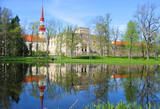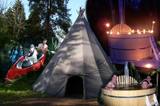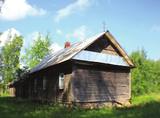| Нo | Название | Описание |
|---|---|---|
|
Z/s Kotiņi pamatnodarbošanās ir graudkopība ar specializāciju sēklkopībā. Vieni no lielākajiem sēklas ražotājiem valstī. Apsaimniekojamās zemes platība ir 4500 ha, no kuriem 3500 ha ir augstu kategoriju sertificētas sēklas lauki. Audzē kviešus, miežus, rapsi, pupas, zirņus, auzas, rudzus, eļļas rutkus, sinepes, griķus, āboliņu, sarkano auzeni, timotiņu, Speltas kviešus. Saimniecība piedāvā produktus ar pievienoto vērtību:
Daļa no Kotiņu produktiem ir atzīti ar zaļās karotītes kvalitātes zīmi! Kotiņi ir saimniecība, kur lieto Latvijā ražotu 100% zaļu enerģiju. |
||
|
Ceļa, kas ved uz jūru – galā, redzami Latvijas piekrastei samērā reti skati. Ja palaimējas, šeit var novērot vietējos zvejniekus darbībā, kas joprojām iet zvejā. Krasta kāpās aplūkojamas vecas, pamestas un arī sagrieztas zvejas liellaivas un dažādi mūsdienu zvejniecībā izmantojami „darba rīki”. |
||
|
Находится в центре Иерики около Иерикупите, где создана природная тропа для осмотра водопадов и мельницы. Своя выпечка. Латышская кухня: Валмиерский салат, холодный суп, суп из фасоли, кусок свинины, жареная треска, купаты, слойка из черного хлеба. Особое блюдо: «Иерикский салат» – помидоры, копченое мясо, шампиньоны. |
||
|
Мельничный ресторан Saaremaa ‒ это место, где Вы найдете блюда, приготовленные по самым любимым рецептам жителей Сааремаа, и где предлагается только самое лучшее и свежее. В меню ‒ дичь из сааремских лесов, летом ‒ копченая рыба, лакомства из ягод, местное яблочное вино, а также лучшие вина острова Сааремаа. |
||
|
Паулс Сукатниекс (1914 - 1989) - первый селекционер винограда жил и работал в «Апситес». В настоящее время жилой дом восстановлен, в нем представлены предметы быта и другие предметы, используемые на сельском дворе, а также библиотека и мастерская П. Сукатниека. Вокруг «Апситес» разбит ухоженный сад, где можно увидеть как местные, так и привезенные сорта декоративных растений, кустарников и деревьев, в т.ч. и редко встречающиеся. Можно осмотреть и ознакомиться с селекционированными П. Сукатниеком сортами винограда и виноградником. Рядом с домом расположен информационный стенд о наблюдении за птицами в пойме Двиете. Желающие могут ознакомиться с садом и с «Апситес» в сопровождении гида. В саду оборудовано место для отдыха и пикника, проводятся толоки (субботники) и образовательные мероприятия |
||
|
Krodziņš "Mežavējš" atrodas Rīgas - Liepājas šosejas 101. kilometrā. Krodziņa ēdienkartē iekļauti latviskie ēdieni. Latviešu virtuve: Skābu kāpostu zupa, biešu zupa, skābeņu zupa, aukstā zupa, kartupeļu pankūkas, plānās pankūkas ar ievārījumu, šmorētas cūkgaļas ribiņas, zemnieku cienasts, mājas kotletes, auzu pārslu kārtojums, rupjmaizes kārtojums. |
||
|
Предлагается рыбалка на озере Усмас. Из улова хозяйка готовит вкусную уху и коптит рыбу. Лодка напрокат, рыбалка, вытягивание сети (даже зимой), катание на катере по озеру. Дегустации консервов, сделанных из копченого леща. Верховая езда. |
||
|
Каменная крепость Пыльтсамаа была построена на берегу реки в 13-ом веке, в 16-ом веке крепость была резиденцией короля Лифляндии Магнуса. Во дворе крепости находятся туристический информационный пункт и музей Пыльтсамаа, винный погреб с Музеем продуктов питания, Эстонский музей прессы, галерея pART, гончарная и ремесленная мастерские. |
||
|
Находитсяк северу отплощади Виенибас. Первая каменная церковь в Илуксте была построена на средства рода графов Платеров – Зибергов в 1754 - 1769 году, а теперешняя – в 1816 году. В 1861 храм г. перешел в распоряжение православного прихода, но в 1920 году был отдан католическому приходу. Церковь восстановили в 1921 году. Во время богослужений храм можно осмотреть изнутри.
|
||
|
До XIII века Смилтенский край входил Талавскую землю, заселенную латгальцами. После вторжения крестоносцев им завладел Рижский архиепископ, возведя на крутом берегу реки Абулы в 1370 году каменный замок. Последующие войны и эпидемии не сберегли ни застройку населенного места, ни жителей. Очертания теперешнего города начали проявляться в конце XIX века в связи с активными действиями князя Ливена - владельца имения «Смилтене». До Первой мировой войны в Смилтене работала деревообрабатывающая фабрика, гидроэлектростанция (1901 г., первая в Балтии) и др. предприятия. Во время пожара, при отступлении немецких войск в 1944 году, сгорела большая часть исторической застройки Смилтене. |
||
|
Усадьба сельского туризма «Карпине» находится в самой середине Литвы. Название «Карпине» возникло от названия рыбы «карп». Ежегодно в усадьбе проводятся мероприятия, связанные с рыболовством. Гости сами могут поймать рыбу и приготовить её. |
||
|
Берег бывшего Балтийского ледникового озера. Мы можем только представить пейзаж, открывавшийся здесь более 10 000 лет назад, когда Курземский полуостров покрывала похожая на тундру растительность и волны ледового озера, в котором плавали айсберги разных размеров, бились о крутые берега. На сегодняшний день более чем 20-километровый (в Слитерском национальном парке – участок длинной около 9 км) и высотой до 42 метров обрыв является одной из наиболее впечатляющих форм рельефа такого рода в Латвии. У его подножия находится равнина Ирвес (название переводится с ливского „īrva, īra” –“лань”) приморской низменности – бывшее дно Балтийского ледового озера. Обрыв голубых гор во многих местах пересекают небольшие ручейки и речушки (Питрагупе, Лорумупе, Калькупе, Maзупе и др.), образуя разветвленные и местами очень сложные системы оврагов, которые особенно впечатляюще выглядят в безлистный период. Во многих местах на самих обрывах, на пересекающих их оврагах и их берегах обнажаются песчаники Нарвской свиты в основном небольшого размера. Это самые старые осадочные породы в Латвии, которые в виде естественных обнажений появляются на поверхности земли. Несмотря на впечатляющие размеры, по всей длине Голубых гор есть только несколько мест с точками широкого обзора (смотровая башня у Дундаги – дороги Мазирбе, вид с маяка Шлитере, вид с Межлидуми) и места, где можно по-настоящему насладиться величием древних берегов (вид на отвесные скалы и обрывы Голубых гор у дорог Цирстес-Мазирбес, Цирстес-Риепалду, Межлидуму и Видалес-Мелнсила). Сюда стоит приехать и весной, когда склоны Голубых гор утопают в яркой зелени черемши. |
||
|
Целью туристического центра Лахемаа является пропаганда природосберегающего образа жизни и умения жить в природе-сажаются деревья и развешиваются домики для птиц. Для интересующихся - походы на каноэ по Лахемааскому национальному парку, походы по болоту и стрельбу из лука и арбалета. Приятно провести время можно в каминном зале и сауне с гидромассажной ванной. |
||
|
Pāvilostā ir trīs parki. Pāvilostas centrā (pie kultūras nama) atrodas Piecdesmitgades parks, kuru 1929. g. iekopa skolotājs un novadpētnieks Ernests Šneiders. Vienu ozolu tajā esot iestādījis Latvijas Valsts prezidents Gustavs Zemgals. Simtgades parks ar piemiņas akmeņiem tapa Sakas labajā krastā jau kā turpinājums iesāktajam. Vecākais no Pāvilostas parkiem - Upesmuižas parks (19. gs.) atrodas tuvu Liepājas – Ventspils šosejai. Upesmuižas pils nav saglabājusies (nodedzināta 1905. g.). Parkā apskatāms sens akmens sols (perimetrs 5,55 m) un Upesmuižas parka Lielais akmens. Domājams, tas ir kultakmens. |
||
|
Моленная Парамоновской старообрядческой общины
построена в 1882 году.
|
||
|
Mākoņkalna pagasta "Itkaču mājās" ir iespēja ieturēt maltīti- plānās pankūkas ar dažādiem pildījumiem, kartupeļu pankūkas, dārzeņu sautējumu. Iespēja apciemot trušus, pabarot tos ,paglāstīt un paturēt sev klēpī. Pieejami saimnieku veidoti suvenīri. |
||
|
В парке находятся пять лабиринтов с декоративными растениями, цветами и лекарственными травами: чабрецом, флоксами, старинными сортами пионов, окопником, зверобоем, жасмином, хеномелесом (японской айвой), зорькой халцедонской, борцом клобучковым, душицей, эстрагоном, примулой, пижмой, чистотелом, девясилом, мятой, золотарником, таволгой и мн. др. Самый длинный маршрут составляет 1,7 км, а общая протяженность дорожек всех пяти лабиринтов: около 4,5 км. Также в парке выставлены три геометрические фигуры: купол, мандала, меркаба. |
||
|
Этот тур сочетает в себе кулинарные впечатления с посещением популярных туристических достопримечательностей на юге Эстонии. Вы посетите Выру и Рыуге, насладитесь пейзажами южной Эстонии в природном парке Хаанья с вершины Суур Мунамяги, самого высокого холма в Прибалтике, и вас искренне приветствуют в Сетомаа, земле Сетоса - этнического и языкового меньшинства, которое продолжает их уникальные традиции наследия. Сетомаа был заселен около 8 400 лет, что делает его одним из старейших населенных пунктов в Эстонии. В этом туре вы попробуете эстонские вина, приготовленные из местных ягод и фруктов, посетите козью ферму, предлагающую превосходный козий сыр, а в деревенской усадьбе вам предложат сытные деревенские блюда. Маршрут начинается и заканчивается в Тарту, но его можно продлить в / из Таллинна и Риги. |
||
|
Находится в 50 м к западу от Лудзенской католической церкви. Построена в 1738 году в форме восьмиугольной ротонды и служила местом отдыха графов Карницких. Небольшое здание с дощатой обшивкой, деревянным потолком и кирпичным полом. Возле капеллы установлена скульптура Девы Марии (1934 г.) работы лудзенского художника Леона Томашицкого - королевы земли Мары. |
||
|
Also known as Lake Jēsis or Lake Iesis, this is the lake in Latvia which has the largest number of islands. Many literary sources and encyclopaedias in the 20th century claimed that there were 69 islands in the lake, but that was an exaggeration, because apparently the authors took sandbars overgrown with reeds and other plants to be islands. The true number is approximately two times lesser. The largest number of islands can be found in the north-eastern part of the lake. The largest one is Lielā Lāča (Big Bear) Island (45 ha). A farm was on the island at one time. The islands and the oak trees that are on the shores of the lake – the Piļoru and Pahatnīku stands of trees – are in a restricted environmental reserve. |
||























